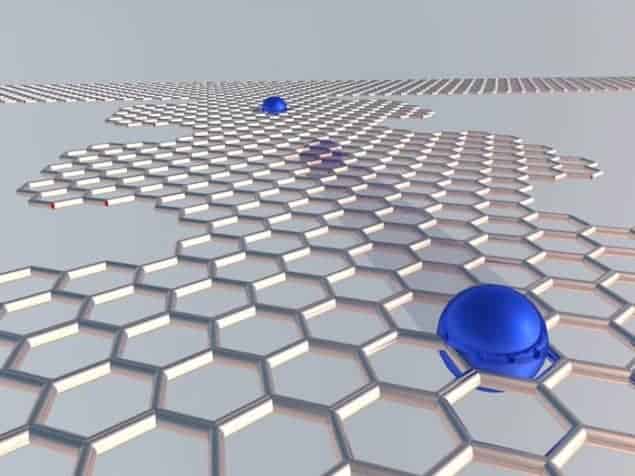
The world’s first single-electron graphene pump has been built by researchers at the UK National Physical Laboratory and the Cavendish Laboratory in Cambridge. The device could be used to redefine the standard unit of current, the ampere, in terms of the electron charge – a fundamental constant of nature.
The international system of units (SI) is made up of seven base units, which are the metre, kilogram, second, kelvin, ampere, mole and candela. The ampere, volt and ohm are the three fundamental units of electricity.
Although physicists have already come up with modern ways to represent the volt and ohm (through measurements of the Josephson voltage and quantum Hall resistance, respectively), there is no equivalent for the ampere. Indeed, today, the ampere is defined as the current which, when flowing through two parallel conductors one metre apart, exerts a certain force between the conductors. Directly realizing such a macroscopic definition of current is experimentally difficult, and the accuracy of the result also depends on other base units, such as the kilogram, which drifts with time.
Enter SEPs
Ideally, a new definition of the ampere would be based on an extremely accurate source of electric current, capable of delivering one electron at a time. A single-electron pump (SEP) could be ideal in this respect because it produces a flow of individual electrons by shuttling them into a quantum dot and emitting them precisely one at a time. A good SEP also pumps the electrons quickly, so a sufficiently large current is generated.
Until recently, two types of SEP were promising contenders: tunable barrier pumps made from semiconductors, which are fast, and so-called hybrid turnstiles made from superconductors, which can be mounted in parallel to make the output current larger. Although the most accurate, a third type of pump usually made from metallic islands is too slow for making a practical current standard, but the UK researchers have now improved its performance by making it from graphene, which is a semi-metal. Graphene is a sheet of carbon just one atom thick that has a honeycomb lattice structure.
Electron flow reaches gigahertz frequencies
“Our experiments have shown that graphene is ideal for pumping large currents and its 2D crystal structure is just what is needed to make electrons pass through the SEP quickly,” team leader Malcolm Connolly told physicsworld.com. The electron flow can reach near-gigahertz frequencies, very close to what is needed to create a current standard, he added.
The team at Cambridge began by peeling a layer of graphene from a piece of graphite using sticky tape. Next, the researchers made the SEP structure by covering some areas of the graphene sheet with a polymer mask and firing an atomic “sandblaster” at the material to “kick” the graphene away from the exposed areas. “One tricky aspect of producing an SEP is making the devices work at high-enough frequencies so that they generate large currents,” explains Connolly. “To this end, we carefully selected the geometry, substrate and pump housing so that the pulses, which pull and push electrons from a reservoir and through the pump, get to where they have to be on time.”
The team says that it still needs to optimize its SEP and make more accurate measurements of the electrical current using the NPL’s high-accuracy set-up. “We also need to work out how the error mechanisms – known to degrade the accuracy of this type of pump – will manifest themselves in graphene,” says Connolly. “Once this is clear, we can then start to mitigate the error mechanisms with modified device designs and concepts.”
Closing the ‘quantum metrological triangle’
If it proves accurate enough, the SEP could also help close the “quantum metrological triangle”, which relates current, voltage and resistance. Voltage can be measured using the AC Josephson effect, while resistance can be related through the quantum Hall effect. Both these relationships include the same two fundamental constants – Planck’s constant, h, and the charge on the electron, e. A metrological current pump would allow physicists to directly relate current to frequency, and thus test whether e and h are as universal as we think.
Besides redefining the ampere, the pump proves that single charges in graphene quantum dots can be manipulated at high frequency, which is an important step towards processing quantum information using single electron spins in graphene. “The carbon atoms making up graphene’s honeycomb lattice should cause less of a disturbance to the electron spin than heavier atoms, a fact that researchers are eager to exploit in these types of devices,” says Connolly.
The work is reported in Nature Nanotechnology.



